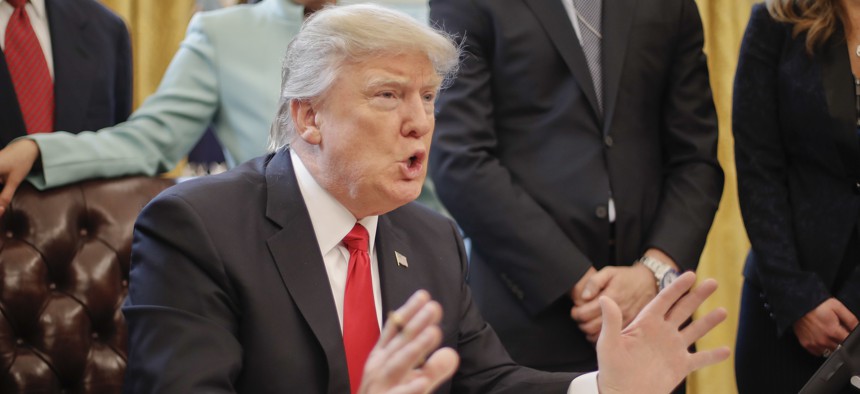
President Donald Trump speaks in the Oval Office of the White House in Washington, Monday, Jan. 30, 2017. AP Photo/Pablo Martinez Monsivais
Trump Says He Fixed F-35 Program in Two Months
The president says the project is “now in good shape,” but pledges to continue considering Super Hornet bids from Boeing.
Less than two months after Donald Trump tweeted that “The F-35 program and cost is out of control” and less than a week after Defense Secretary James Mattis ordered a review with an eye toward cost-cutting, the president says the project is “now in good shape.”
“The F-35 fighter jet — a great plane by the way, I have to tell you, and Lockheed is doing a very good job as of now,” Trump said Monday at a meeting with small business leaders at the White House. “There were great delays, about seven years of delays, tremendous cost overruns. We've ended all of that and we've got that program really, really now in good shape, so I'm very proud of that.”
In reality, the F-35 has been doing better for about half a decade now. Consider that between 2001 and 2011, the program was delayed six years and blew its budget by $13 billion , according to Lt. Gen. Christopher Bogdan, the general in charge of the project. Since its restructuring in 2011, the program has hit many of its milestones, though Bogdan said last month that the program might need $532 million more to complete flight testing and the Pentagon’s testing office warned of possible delays to come.
And the cost of the jet has been declining rather steadily for five years, a Defense One analysis found. Since 2007, the Pentagon has ordered nine batches of F-35s. The price tag of the F-35A — the version flown by the U.S. Air Force and most allies — has fallen with each order. For example, F-35As in the seventh order cost 5 percent less than those in the sixth order, and so on.
But when officials from Lockheed and the Pentagon sat down in 2015 to negotiate a price for the ninth batch, they were unable to come to terms. Some 14 months of negotiations led, in November, to a take-it-or-leave offer from DoD: 57 planes for $6.1 billion. Lockheed has until Tuesday to appeal the contract to the Armed Services Board of Contract Appeals.
Related:
The Price of an F-35 Was Already Falling. Can Trump Drive it Lower?
Related:
Pentagon Tester: F-35 Program Rushing Tests, Delays Still Likely
Related:
F-35 Production Set to Quadruple As Massive Factory Retools
Last Tuesday, Marillyn Hewson, the firm’s chairman, CEO and president, was asked on a quarterly earning call whether Lockheed would take legal action. “We are just going to continue to look at our options,” she said.
But she also said that negotiations on the 90-plane tenth batch were nearly their conclusion. On Tuesday, Hewson said Lockheed and Boeing were “close to a deal” that would see the F-35A’s price tag drop below $100 million.
It appears to be this deal that Trump is claiming to have shaped.
“I got involved in that about a month ago,” Trump said this morning. “There was no movement and I was able to get $600 million approximately off those planes.”
That would represent about $6.6 million per plane, or about a 6.5-percent drop between the ninth and tenth batches.
As president-elect, Trump met with Hewson twice, one at his compound in Palm Beach, Florida, and once at Trump Tower in Manhattan. The aerospace CEO also was at the White House one week ago when Trump met with business leaders.
Trump also suggested that his December invitation to Boeing to “price-out a comparable F-18 Super Hornet” had helped bring the cost down.
“I appreciate Boeing for coming in and competing and now they'll be competing during the process for the rest of the planes, because there are thousands of more planes coming. We have a lot of planes coming,” he said this morning.
What did Lockheed have to say about this? Here’s a company statement: “We appreciate President Trump’s comments this morning on the positive progress we’ve made on the F-35 program. We share his commitment to delivering this critical capability for our men and women in uniform at the lowest possible cost to taxpayers.”
Meanwhile, Trump’s new defense secretary has ordered up a pair of reviews on the program. Last Thursday, Mattis ordered Deputy Defense Secretary Bob Work to “oversee a review of the F-35 program to determine opportunities to significantly reduce the cost of the F-35 program while meeting the requirements.” Mattis also ordered a review “that compares F-35C [the naval version] and F/A-18E/F [Super Hornet] operational capabilities and assesses the extent that the F/A-18E/F improvements (an advanced Super Hornet) can be made in order to provide a competitive, cost effective, fighter aircraft alternative.”
Boeing has been working on a souped-up version of the F/A-18, one that can fly farther and faster than the ones flown today by the Navy.
The Pentagon plans to buy 2,443 F-35s. So far the U.S and its allies have ordered a total of 373, of which Lockheed has delivered 66, with the same number slated for delivery this year Hewson said.
